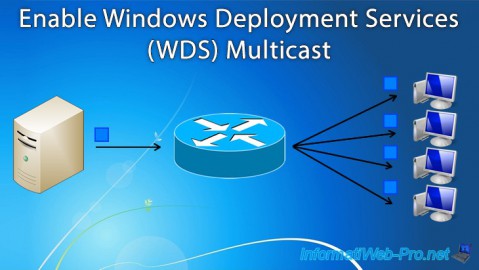Install and configure Windows Deployment Services (WDS) on Windows Server 2008
- Windows Server
- WDS
- 11 August 2012 at 16:11 UTC
-

- 2/5
2. Placing images (Boot and installation)
Right click on "Boot Images" and click "Add Boot Image".

Click "Browse".

Depending on the version of the OS installed (32 or 64 bits), use a boot image (boot.wim) of a Windows (Vista/7/2008/2008 R2/ or higher, 32 or 64 bits). Usually when you buy a Windows Vista, Windows 7 or else you always have 2 CD / DVD. 1 which contains the 32-bit version of the OS and the other 64-bit version.
For this tutorial, I've copied my boot.wim files (boot image) and install.wim (Installation Image) of my installations DVD on my server. These two files are still listed in the "sources" folder on each DVD.
Note : Windows XP is left before Microsoft uses these images called "Windows Imaging", it will use a more recent picture of a Windows startup and make a capture of the installation to deploy later but we'll see about that after.
Select a boot.wim file (regardless of the source, but it's Windows 32-bit) and click "Open".

Once selected, click "Next" picture.

Regardless of the image comes from Vista / 7 or others. Name the 32-bit image "Install a Windows 32-bit (x86).

Click "Next".

The wizard adds the selected boot image.

The boot image is now added.

Now repeat the same procedure with a 64-bit boot image to withstand all clients.
To do this right click on "Boot Images" and click "Add Boot Image".

Select the boot.wim file from a 64 bit version of Windows Vista / 7 / ...

Name the 64-bit image "Install a Windows 64-bit (x64).

Click "Next".

The wizard adds the 64-bit boot image.

Once the 2 images added start, we must now add the installation images. These are images that contain files to install Windows Vista / 7 / Server 2008 / ... according to the selected install.wim file.

Right-click on "Install Images" and click "Add an install image".

Created at least one folder (group) by OS (Windows), because Windows always comes in several differents editions. So if you select all for each version 32/64 bits, you will have long lists so as to separate early. The client will not notice a thing.
We'll start in chronological order of Windows versions release listed above. So we start with Windows Vista because Windows XP is more complicated to deploy, therefore, we will do later to let you know first how WDS works.

Click on "Browse".

Select the install.wim file from the Windows to install. Caution unlike boot images you need to select the wim file of the Windows (Vista / 7 ... and if it's 32 or 64 bits) you want to install.

Once selected wim file, click "Next".

Select wanted editions of Windows, you want to add to your deployment server.
Warning : each edition have its serial number, so if you install another edition than the one you bought Windows install in evaluation mode and you will need a serial number for the edition you have just install. Against by the serial number is valid as well for 32 Bits 64 Bits otherwise we would not put you the 2 DVD in the same box elsewhere.

The wizard displays a summary of selected (32-bit) editions to add to the deployment server.

The wizard checks the integrity of the "install.wim" file to see if the file isn't corrupt.

If the file is not corrupted, the wizard adds the selected images. (1 per edition).
Note : This process may take some time depending on the performance of your server and the number of selected editions.

Once the images are added, click "Finish".

To support all clients, we will also add 64-bit version of Windows Vista (or Windows that you just added). To do this click on "Windows Vista" in the left column (if it's not already do) and right click on the right side. Then click on "Add an install image".

Click on "Browse".

Select this time the 64-bit Windows file you want (in this case the Windows Vista 64-bit).

Once selected wim file, click "Next".

Select editions of Windows wanted, you want to add to your deployment server.
Warning : each edition have a serial number, so if you install another edition than the one you bought Windows install in evaluation mode and you will need a serial number for the edition you have just install. Against by the serial number is valid as well for 32 Bits 64 Bits otherwise we would not put you the 2 DVD in the same box elsewhere.

The wizard displays a summary of selected (64-bit) editions to add to the deployment server.

The wizard checks the integrity of the "install.wim" file to see if the file isn't corrupt.

The wizard adds selected editions. As you can see, there is less of editions 64 Bits.

Once the images are added you will see the list of images to display. As you can see we already have 11 lines for Windows 32 & 64 Bit. That is why we created a group before you add them.

Add other Windows if you wish. In our case we added all 32 and 64-bit of Windows 7 and Windows Server 2008.
Windows XP group is empty at the moment because we're going to capture a Windows XP installation. Just because Windows XP doesn't use the system called "Windows Imaging".



No comment